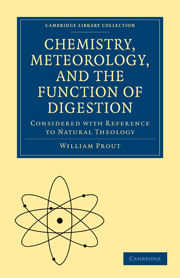Book contents
- Frontmatter
- TO THE READER [FIRST EDITION]
- TO THE READER [SECOND EDITION]
- Contents
- Dedication
- INTRODUCTION
- BOOK I OF CHEMISTRY
- BOOK II OF METEOROLOGY
- CHAPTER I OF THE GENERAL STRUCTURE OF THE EARTH; PARTICULARLY WITH REFERENCE TO THE DISTRIBUTION OF ITS SURFACE INTO LAND AND WATER; AND WITH RESPECT TO ITS ATMOSPHERE
- CHAPTER II OF HEAT AND LIGHT: THE MODES OF ESTIMATING THEIR DEGREE, AND THE WAYS IN WHICH THEY ARE PROPAGATED. OF THE GENERAL TEMPERATURE OF THE CELESTIAL REGIONS, AND OF THE EARTH INDEPENDENTLY OF THE SUN
- CHAPTER III OF THE TEMPERATURE OF THE EARTH AT ITS SURFACE, AS DEPENDENT ON THE SUN
- CHAPTER IV OF THE PRIMARY CONSTITUENTS OF CLIMATE: OR OF THE TEMPERATURE OF THE EARTH, AS DEPENDENT ON ITS GLOBULAR FORM; AND ON ITS ANNUAL AND DIURNAL MOTIONS
- CHAPTER V OF THE SECONDARY OR SUBSIDIARY CONSTITUENTS OF CLIMATE; COMPREHENDING A SKETCH OF THOSE CIRCUMSTANCES CAPABLE OF INFLUENCING CLIMATE, WHICH ARE MORE IMMEDIATELY CONNECTED WITH THE SURFACE OF THE EARTH, AS CONSISTING OF LAND OR WATER; OR WHICH ARE CONNECTED WITH THE ATMOSPHERE
- CHAPTER VI OF THE ADAPTATION OF ORGANIZED BEINGS TO CLIMATE; COMPREHENDING A GENERAL SKETCH OF THE DISTRIBUTION OF PLANTS AND ANIMALS OVER THE EARTH, AND OF THE PRESENT POSITION AND FUTURE PROSPECTS OF MAN
- BOOK III OF THE CHEMISTRY OF ORGANIZATION
- APPENDIX
CHAPTER IV - OF THE PRIMARY CONSTITUENTS OF CLIMATE: OR OF THE TEMPERATURE OF THE EARTH, AS DEPENDENT ON ITS GLOBULAR FORM; AND ON ITS ANNUAL AND DIURNAL MOTIONS
Published online by Cambridge University Press: 29 August 2010
- Frontmatter
- TO THE READER [FIRST EDITION]
- TO THE READER [SECOND EDITION]
- Contents
- Dedication
- INTRODUCTION
- BOOK I OF CHEMISTRY
- BOOK II OF METEOROLOGY
- CHAPTER I OF THE GENERAL STRUCTURE OF THE EARTH; PARTICULARLY WITH REFERENCE TO THE DISTRIBUTION OF ITS SURFACE INTO LAND AND WATER; AND WITH RESPECT TO ITS ATMOSPHERE
- CHAPTER II OF HEAT AND LIGHT: THE MODES OF ESTIMATING THEIR DEGREE, AND THE WAYS IN WHICH THEY ARE PROPAGATED. OF THE GENERAL TEMPERATURE OF THE CELESTIAL REGIONS, AND OF THE EARTH INDEPENDENTLY OF THE SUN
- CHAPTER III OF THE TEMPERATURE OF THE EARTH AT ITS SURFACE, AS DEPENDENT ON THE SUN
- CHAPTER IV OF THE PRIMARY CONSTITUENTS OF CLIMATE: OR OF THE TEMPERATURE OF THE EARTH, AS DEPENDENT ON ITS GLOBULAR FORM; AND ON ITS ANNUAL AND DIURNAL MOTIONS
- CHAPTER V OF THE SECONDARY OR SUBSIDIARY CONSTITUENTS OF CLIMATE; COMPREHENDING A SKETCH OF THOSE CIRCUMSTANCES CAPABLE OF INFLUENCING CLIMATE, WHICH ARE MORE IMMEDIATELY CONNECTED WITH THE SURFACE OF THE EARTH, AS CONSISTING OF LAND OR WATER; OR WHICH ARE CONNECTED WITH THE ATMOSPHERE
- CHAPTER VI OF THE ADAPTATION OF ORGANIZED BEINGS TO CLIMATE; COMPREHENDING A GENERAL SKETCH OF THE DISTRIBUTION OF PLANTS AND ANIMALS OVER THE EARTH, AND OF THE PRESENT POSITION AND FUTURE PROSPECTS OF MAN
- BOOK III OF THE CHEMISTRY OF ORGANIZATION
- APPENDIX
Summary
The distance of the earth from the sun is such, that the solar rays may be supposed to arrive at the earth's surface in a state of parallelism. Now, when parallel rays fall upon a globe, it is obvious, that any number of such rays falling perpendicularly, as at the equator of our earth, will occupy a very different portion of the surface of the globe; from what an equal number of the same rays will occupy, where they fall obliquely, as in our polar regions. Hence, as we recede from the equator towards each pole, heat and light are diffused, over gradually increasing portions of the earth's surface; and thus the intensity of both decreases in a like proportion. The exact law of such decrease is well known to mathematicians, but need not be here repeated. For our present purpose it is sufficient to observe, that among the natural causes affecting the distribution of heat and light in different latitudes, the globular figure of the earth is the principal.
The second great natural cause of the unequal distribution of heat and light over the earth, is the obliquity of the earth's motion in its orbit, with respect to the plane of its equator. From this obliquity it happens, that, during the annual revolution of the earth round the sun, every part of its surface, between the latitudes of 23½° north and south from the equator, is in turn exposed to the perpendicular influence of the sun.
- Type
- Chapter
- Information
- Chemistry, Meteorology and the Function of Digestion Considered with Reference to Natural Theology , pp. 230 - 233Publisher: Cambridge University PressPrint publication year: 2009First published in: 1834



